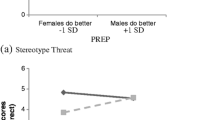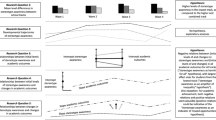Abstract
Numerous stereotypes exist regarding race and gender, and while all are difficult to eradicate, one still regnant throughout society is the notion that females are not as capable as males within the fields of math and science. In order to expose this belief as faulty, an in depth literature review was initiated, with special attention being placed on interventions considered helpful in eliminating stereotype threat. The paper’s primary purpose centered on how, and to what extent, stereotype threats affect the mathematics scores of females and minorities. In addition, case studies and a critical perspective regarding the research, as well as suggestions for future research, are discussed.
Similar content being viewed by others
References
Aronson J., Fried C.B. and Good C. (2002). Reducing the effects of stereotype threat on African American college students by shaping theories of intelligence. Journal of Experimental Psychology 38: 113–125
Blanton H., Christie C. and Dye M. (2002). Social identity versus reference frame comparisons: The moderating role of stereotype endorsement. Journal of Experimental Social Psychology 38(3): 253–267
Bolick C. (1996). The affirmative action fraud: Can we restore the American civil rights vision?. The Cato Institute, Washington, DC
Brown R.P. and Josephs R.A. (1999). A burden of proof: Stereotype relevance and gender differences in math performance. Journal of Personality and Social Psychology 76(2): 246–257
Bussey K. and Bandura A. (1992). Self-regulatory mechanisms governing gender development. Child Development 63: 1236–1250
Cadinu M., Maass A., Frigerio S., Impagliazzo L. and Latinotti S. (2003). Stereotype threat: The effect of expectancy on performance. European Journal of Social Psychology 33: 267–285
Catsambis S. (1994). The path to math: Gender and racial-ethnic differences in mathematics participation from middle school to high school. Sociology of Education 67: 199–215
Contrada R.J., Ashmore R.D., Gary M.L., Coups E., Egeth J.D., Sewell A, Ewell K., Goyal T.M. and Chasse V. (2000). Ethnicity-related sources of stress and their effects on well-being. Current Directions in Psychological Science 9: 136–139
Croizet J. and Claire T. (1998). Extending the concept of stereotype threat to social class: The intellectual underperformance of students from low socioeconomic backgrounds. Personality and Social Psychology Bulletin 6: 588–594
Eccles J.S. (1987). Gender roles and women’s achievement-related decisions. Psychology of Women Quarterly 11: 135–172
Eccles J.S. (1994). Understanding women’s educational and occupational choices: Applying the Eccles et~al. model of achievement-related choices. Psychology of Women Quarterly 18: 585–609
Eccles J.S. and Harold R.D. (1992). Gender differences in educational and occupational patterns among the gifted, (1990). In: Colangelo, N., Assouline, S.G. and Ambroson, D.L. (eds) Talent development: Proceedings from the 1991 Henry B. and Jocelyn Wallace National Research Symposium on Talent Development, pp 3–29. Trillium Press, Unionville, NY
Ernest J. (1976). Mathematics and Sex. American Mathematical Monthly 83: 595–614
(1997). Off White: Readings on Race, Power and Society. Routledge, New York
Freeman A. (2003). Raising minority achievement in science and math. Educational Leadership 60: 31–40
Gonzales P.M., Blanton H. and Williams K.J. (2002). The effects of stereotype threat and double-minority status on the test performance of Latino women. Personality & Social Psychology Bulletin 28: 659–670
Good C., Aronson J. and Inzlicht M. (2003). Improving adolescents’ standardized test performance: An intervention to reduce the effects of stereotype threat. Applied Development Psychology 24: 645–662
Hall C.W. and Davis N.B. (1999). Gender and racial differences in mathematical performance. Journal of Social Psychology 139(6): 677–689
Halpern D.F. (2000). Sex Differences in Cognitive Ability. Lawrence Erlbaum Associates, Mahwah, NJ
Huston, A. C. (1983). Sex typing. Handbook of child psychology: Vol. 4. Socialization, personality, and social development (4th ed., pp. 387–467). New York: Wiley
Hyde J.S., Fennema E. and Lamon S.J. (1990). Gender differences in mathematics performance: A~meta-analysis. Psychological Bulletin 107: 139–155
Inzlicht M. and Ben-Zeev T. (2000). A threatening intellectual environment: Why females are susceptible to experiencing problem-solving deficits in the presence of males. Psychological Science 11(5): 366–371
Inzlicht M. and Ben-Zeev T. (2003). Do high-achieving female students underperform in private? The implications of threatening environments on intellectual processing. Journal of educational Psychology 95(4): 796–805
Jost J.T. and Banaji M.R. (1994). The role of stereotyping in system-justification and the production of false consciousness. British Journal of Social Psychology 33: 1–27
Keller J. (2002). Blatant stereotype threat and women’s math performance: self-handicapping as a strategic means to cope with obtrusive negative performance expectations: Brief report. Sex Roles 47: 193–198
Levy S.R. and Dweck C.S. (1999). The impact of children’s static versus dynamic conceptions of people on stereotype formation. Child Development 70: 1163–1180
Liben L.S. and Signorella M.L. (1980). Gender related schemata and constructive memory in children. Child Development 51: 11–18
Martin C.L. and Little J.K. (1990). The relation of gender understanding to children’s sex-typed preferences and gender stereotypes. Child Development 61: 1427–1439
Marx D.M. and Roman J.S. (2002). Female role models: Protecting women’s math test performance. Personality and Social Psychology Bulletin 28: 1183–1193
Mau W. and Lynn R. (2000). Gender differences in homework and test scores in mathematics, reading and science at 10th and 12th grade. Psychology, Evolution, and Gender 2: 119–125
McIntyre R.B., Lord C.G., Gresky D.M., Ten Eyck L.L., Frye G.D.J. and Bond C.F. (2005). A social impact trend in the effects of role models on alleviating women’s mathematics stereotype threat. Current Research in Social Psychology 10(9): 116–136
McIntyre R.B., Paulson R.M. and Lord C.G. (2003). Alleviating women’s mathematics stereotype threat through salience of group achievements. Journal of Experimental Social Psychology 39: 83–90
McKown C. and Weinstein R.S. (2003). The development and consequences of stereotype consciousness in middle childhood. Childhood Development 74(2): 498–515
National Science Foundation. (2001). Science and Engineering Degrees, by Race/Ethnicity of Recipients: 1990–1998. Arlington, VA: National Science Foundation.
Nadya F.A. (1995). Career linking: An intervention to promote math and science career awareness. Journal of Counseling & Development 73(5): 527–534
O’Brien L. and Crandall C. (2003). Stereotype threat and arousal: Effects on women’s math performance. Personality and Social Psychology Bulletin 29(6): 782–789
Osborne J.W. (2001). Testing stereotype threat: Does anxiety explain race and sex differences in achievement?. Contemporary Educational Psychology 26: 291–310
Oswald D.L. and Harvey R.D. (2003). A q-methodological study of women’s subjective perspectives on mathematics. Sex Roles 49: 133–142
Oswald D.L. and Harvey R.D. (2001). Hostile environments, stereotype threat and math performance among undergraduate women. Current Psychology 19(4): 44–64
Quinn D.M. and Spencer S.J. (2001). The interference of stereotype threat with women’s generation of mathematical problem-solving strategies. Journal of Social Issues 57(1): 55–71
Reyna C. (2000). Lazy, Dumb, or industrious: When stereotypes convey attribution information in the classroom. Educational Psychology Review 12(1): 86–110
Rosenthal H.E.S. and Crisp R.J. (2006). Reducing stereotype threat by blurring intergroup boundaries. Personality & Social Psychology Bulletin 32(4): 501–512
Schmader T. (2002). Gender identification moderates stereotype threat effects on women’s math performance. Journal of Experimental Social Psychology 38: 194–201
Schmader T., Johns M. and Barquissau M. (2004). The costs of accepting gender differences: The role of stereotype endorsement in women’s experience in the math domain. Sex Roles 50: 835–850
Shih M., Pittinsky T.L. and Ambady N. (1999). Stereotype susceptibility: Identity salience and shifts in quantitative performance. American Psychological Society 10(1): 81–83
Sleeter C. (1997). Mathematics, multicultural education and professional development. Journal for Research in Mathematics Education 28: 680–696
Spencer S.J., Steele C.M. and Quinn D.M. (1999). Stereotype threat and women’s math performance. Journal of Experimental Social Psychology 35: 4–28
Steele C.M. (1997). A threat in the air: How stereotypes shape intellectual identity and performance. American Psychologist 52: 613–629
Steele C.M. and Aronson J. (1995). Stereotype threat and the intellectual test performance of African Americans. Journal of Personality and Social Psychology 69(5): 797–811
Steele J., James J., and Barnett R.C. (2002). Learning in a man's world: Examining the perceptions of undergraduate women in male-dominated academic areas. Psychology of Women Quarterly, 26 38-64.
Stone J., Lynch C.I., Sjomeling M. and Darley J.M. (1999). Stereotype threat effects on black and white athletic performance. Journal of Personality and Social Psychology 77: 1213–1227
Walsh M., Hickey C. and Duffy J. (1999). Influence of item content and stereotype situation on gender differences in mathematical problem solving. Sex Roles 41: 219–240
Author information
Authors and Affiliations
Corresponding author
Rights and permissions
About this article
Cite this article
Smith, C.S., Hung, LC. Stereotype threat: effects on education. Soc Psychol Educ 11, 243–257 (2008). https://doi.org/10.1007/s11218-008-9053-3
Received:
Accepted:
Published:
Issue Date:
DOI: https://doi.org/10.1007/s11218-008-9053-3




